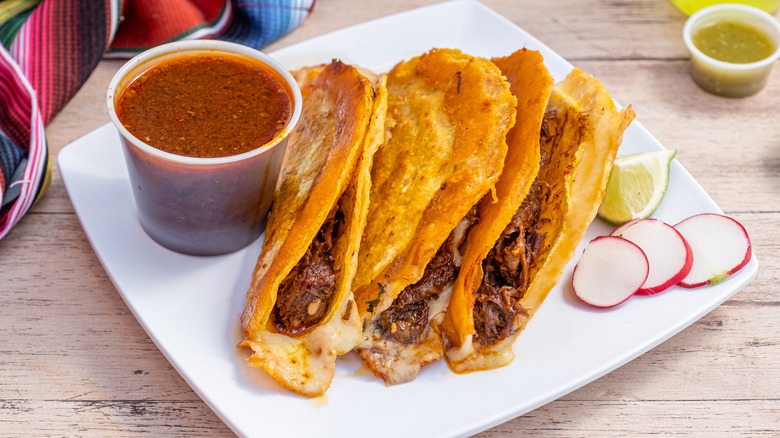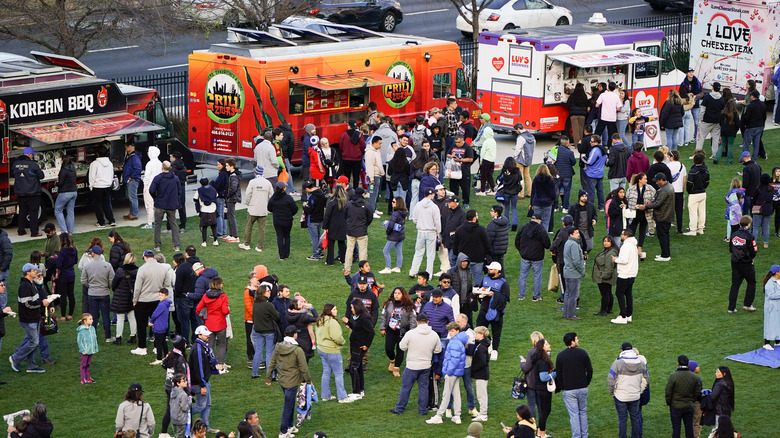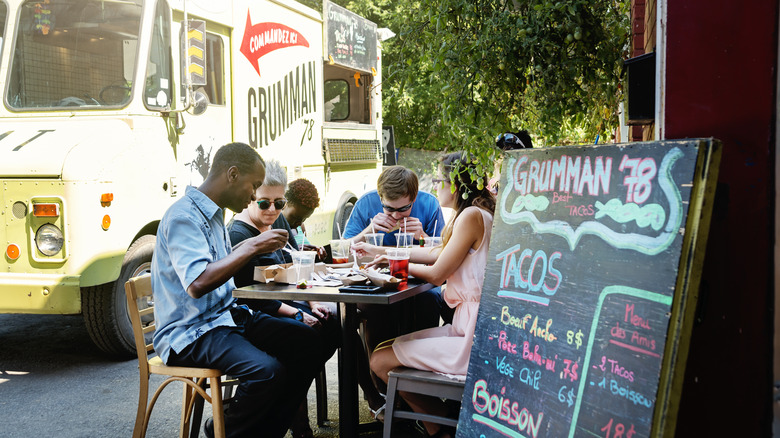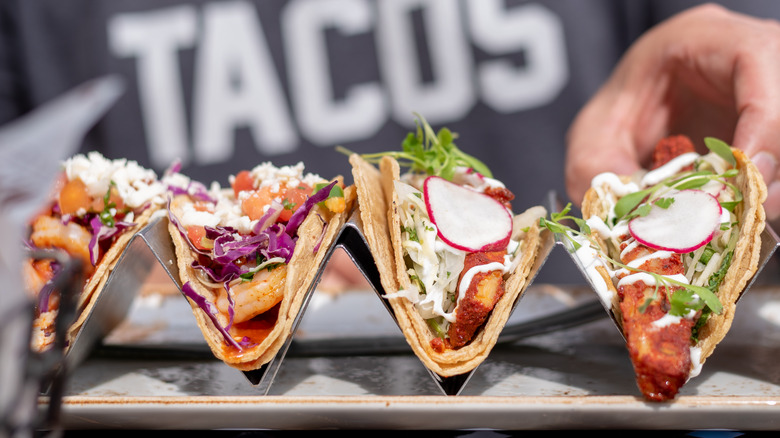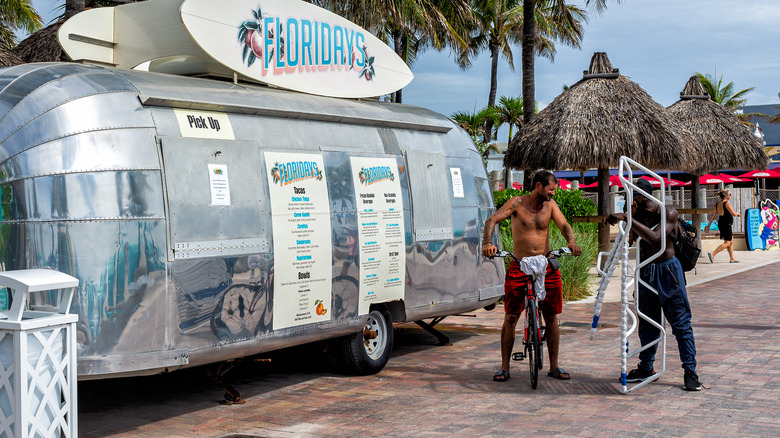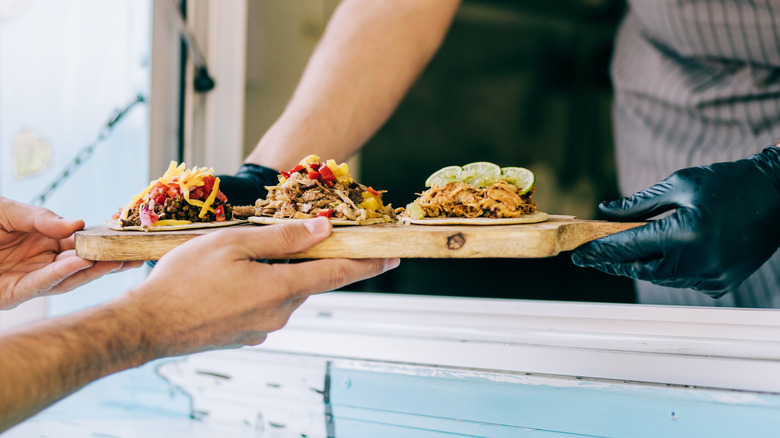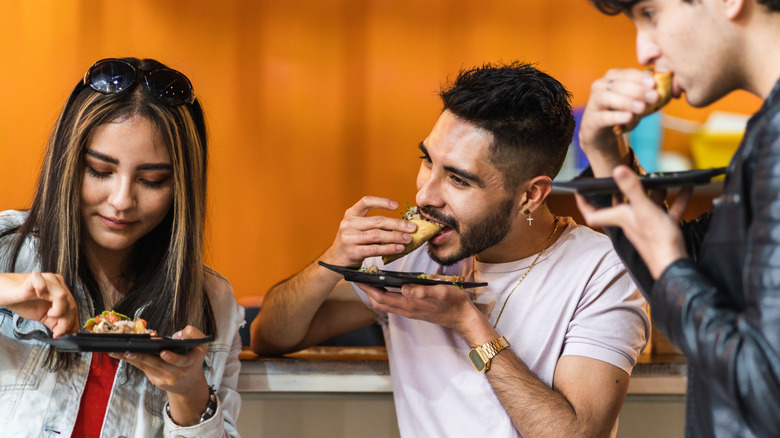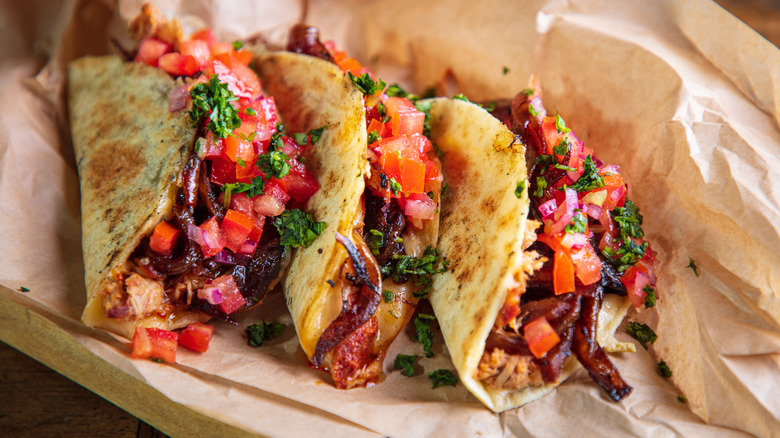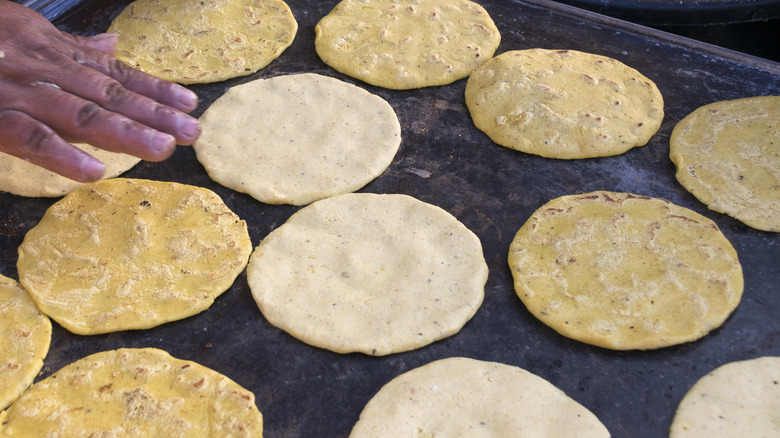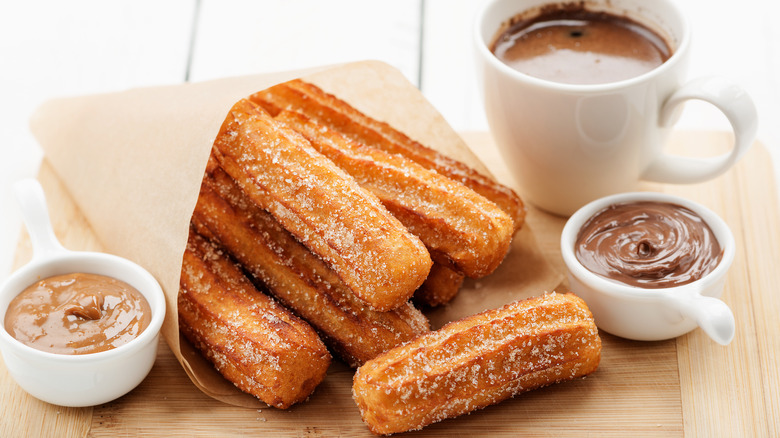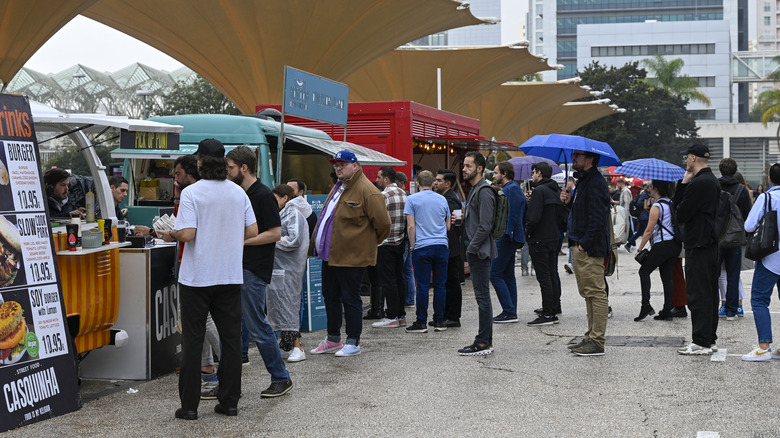How To Order From A Taco Truck Like A Pro, According To Experts
With 40,000 food trucks currently in operation in the United States alone, no matter what you're hungry for, you can find a truck that specializes in it. Taco trucks, in particular, are some of the most spectacular and beloved of all our mobile dining options. They're convenient, traditional yet innovative, and also tend to be open late — which is great if that's when you're most in the mood for a taco.
Taco trucks tend to have incredible variety and can quickly immerse you in a vibrant culture you may not know much about — and that experience is part of their charm. But for some of us, placing our taco truck order can also be intimidating — especially if the menu is unfamiliar or we're not exactly sure what we'll be getting, or how spicy it might be. If that sounds familiar, fear not. We're here to help take some of the worry (or guesswork) out of ordering from a taco truck. Read on for some expert advice from a few of the country's leading taco purveyors, and in no time, you'll be ordering like a pro.
Find the right truck
Part of the beauty of the food truck experience is that you never fully know what you're going to find when you're out and about. While some food trucks have one consistent spot they operate from, many of these mobile restaurants end up wherever the day takes them. In other words, when you're looking for a bite of some authentic Mexican cuisine, you may not always know where the best taco trucks are hiding on any given afternoon or evening.
One of the easiest and most efficient options for finding your city's best food trucks — and taco trucks in particular — is to go where the people are. During the work week, check out areas with lots of office buildings where hungry folks will flock to get something fun and perhaps a bit different from their usual grab-and-go offerings. In the evenings and on weekends, look for sporting events, concerts or music festivals, and street fairs — the sort of vibrant and thriving locations that all kinds of food trucks, including taco trucks, tend to be drawn to.
Chef Carlos Leyva, who operates the popular Los Angeles-based El Mas Chingon taco truck also suggests grabbing your phone and checking sites like Instagram, Facebook, Yelp, or TripAdvisor. And you can look for local food truck associations, like the Los Angeles Food Truck Association (of which he is a member), to get a full directory of local options. Apps like "Roaming Hunger" and "StreetFoodFinder" can help you track down many taco trucks that might be parked nearby.
Approach with an open mind
Once you find the taco truck you've been craving and you're ready to place your order, all of our experts agree that it's essential to check out the menu and make your decisions with an open mind.
For chef Mark Adams, whose award-winning Holy Chile Mole taco truck operates throughout southern California, the best advice he says he could give anyone to help them order like a pro is to simply get excited about the food you're about to be eating. "The biggest thing I'd recommend for a first-timer is to just be curious!" he says. "Ask questions to the staff running the order window, and be willing to try new things or recommendations."
Octavio Diaz, owner and operator of the Mitote Food Park, a mecca for taco trucks of all types located in Santa Rosa, California agrees. "Don't be afraid to ask questions," Diaz says. "People are usually really happy to explain what their menu is ..."
"Don't get intimidated!" adds chef Leyva. "Mexican culture is rich and diverse, and [the menu] may have ingredients that you are unfamiliar with. But stay polite and respect the culture. It's important to be willing to try new things because even the simplest of options is sure to impress."
Know some taco basics
A lot of Mexican food is made with similar ingredients, which are used in different ways — so it can be very easy to get confused over how dishes differ from one another. If you're curious, most food experts define a taco as any sort of traditional-style Mexican dish that consists of a folded or rolled tortilla filled with meat, beans, veggies, or other toppings. In contrast, tostadas are similar but are made with a crisp (and always flat) tortilla base. Tortas are Mexican sandwiches, and sopes are like a tostada but with a thicker, doughier base shell.
Continuing down the list, flautas (aka taquitos) are rolled tacos filled with shredded meat and deep-fried until crispy. Quesadillas are also folded or rolled and almost always include a large amount of gooey melted cheese. With burritos, the ingredients are again rolled inside the tortilla right before the dish is served. And with an enchilada, that tightly rolled burrito is also smothered with sauce and generally baked again before being served. Tacos are unique among all these examples — because they are served in an open-faced folded tortilla shell immediately after being prepared, without any further cooking.
According to Octavio Diaz, owner and operator of the Mitote Food Park, it's important to always know these basic distinctions between the styles of different dishes, because a lot of trucks might call similar-style meals by different names. "... look at what the theme of the truck is," he adds. "If everything looks daunting, find something familiar."
Navigate the menu top down
In a standard brick-and-mortar restaurant, the menu is typically designed in a leisurely progression. You'll see appetizers first, then salads, followed by entrees and finishing with desserts — in much the same order as your meal will likely be served. Taco trucks take a different approach. They want to catch a consumer's eye quickly and draw you in instantly by promoting a delicious dish that you didn't know you were hungry for or that you suddenly need to have "right now" as you're passing by and going about your day.
"When it comes to most trucks, they'll make sure to advertise their best stuff first and foremost on menus," chef Mark Adams, owner of the award-winning Holy Chile Mole, tells us. "Or, they'll make sure to show off their popular items with bigger descriptions or pictures. An item that's the first choice on a menu is usually pretty popular, and if they're advertising a special, you can't go wrong giving it a try!"
Also, remember that the space inside a taco truck is limited. It's not like a cafe or fast food joint that can have dozens upon dozens of different menu options stashed away in the freezer. So don't expect a giant menu, and don't be surprised if you only have a handful of dishes to pick from — that's actually a good thing. According to Mitote Food Park owner Octavio Diaz, that kind of specialization is a great sign. If a truck only has four or five items on the menu, you know they're all killer, he says.
Know some taco specific lingo
You don't have to have a fluid mastery of Spanish to order tacos from a food truck like a pro, but knowing just a few keywords can greatly improve your experience, advises chef Carlos Leyva, who operates the popular Los Angeles-based El Mas Chingon taco truck. "Learn some of the basic translations of Spanish to English to better understand what you're gonna get when you order the carnitas," he says.
With that in mind, here are a few of the most common taco varieties to know and remember: Tacos al Pastor are "shepherd-style" tacos made with marinated pork and often paired with pineapple. Birria tacos are usually made with tender, shredded beef or goat. Carnitas are also made with braised, shredded meat, but this time, it's pork. Barbacoa tacos tend to be made with stewed meats and have a bolder, smokier flavor than "regular" tacos. Finally, "Asada-style" tacos are typically made with grilled meats that have been marinated in lime juice, salt, and Mexican seasonings.
Pick your taco based on this essential knowledge, or just ask the truck's operators which taco they like best from their menu, chef Mark Adams, Holy Chile Mole, says. "I believe each truck has their own item they love to cook that, for some odd reason, people hardly ever order," he says. "The next time you go to a food truck, be sure to ask if they have any personal favorites that they'd love to cook for you. You might be surprised what you get, and if you're lucky, you might even get a secret menu item."
Consider toppings in advance — and adjust your order accordingly
"When trying a new food truck, stick to the basics to avoid surprises," says Carlos Leyva, owner of taco truck El Mas Chingon. "Salsas and protein choices may differ depending on the specific truck, so it's wise to opt for familiar options initially. Chat with staff to understand the differences and explore any signature dishes or flavors unique to their menu. They'll point you in the right direction."
Don't like onions or suffer from heartburn after eating lots of acidic tomatoes? Tacos are one of the best foods around for customizing exactly to your liking, says Holy Chile Mole's chef Mark Adams. "There's no shame in having special dietary restrictions or simply not liking a certain item on your food, so be sure to start off your order mentioning any restrictions you may have."
"One of the best things, in my opinion, about a food truck is the people preparing the food are right there," adds Octavio Diaz, owner of the Mitote Food Park. "And so, especially with a taco, nothing is pre-made. So when you're trying to suit your preferences or have dietary needs, it's actually the perfect device to get your food on because they haven't prebuilt anything. If you're vegan, eliminate the meat options, take off the cheese. If you're vegetarian, they can throw on more veg. A taco is literally one of the most flexible items you can order, and with you being right there at the face of the taco truck, you can definitely get it the way you want it."
Calculate heat levels
The biggest issue many people have when navigating a food truck menu — and ordering like a pro — centers around the spiciness of different dishes. "I commonly hear feedback from people that they wish they knew something was spicy," says food truck owner Octavio Diaz. "So, to save yourself from spending your money the wrong way, make sure you ask if the item has something you don't like on it."
In general, remember that bell peppers, poblano peppers, and Anaheim peppers tend to be the most mild if you're sensitive to heat. Jalapeño peppers and serrano peppers are moderately spicy and provide a noticeable kick of heat without being overly intense. And habanero peppers and ghost peppers are extremely hot and can add intense fire to dishes. See a Carolina Reaper on the menu? Beware! This is one of the hottest peppers of all.
As a home cook, there are tips and tricks you can try to moderate the heat in the peppers you serve. But at a food truck, you need to rely on the truck's operators for guidance. You might consider requesting your taco plain or with no sauce, but that's a big mistake, according to Mark Adams of Holy Chile Mole. "Plenty of trucks take pride in their sauces or garnishes, and removing them usually makes your dish incomplete," he says. If you're worried about heat, order your sauce on the side instead so you can dip your taco into it and better control just how much gets onto each bite.
Think through potential spur of the moment decisions
Another key aspect of ordering from a taco truck like a pro, according to our experts, is thinking through some of the many "either/or" type choices you might have to instantly make while ordering. Your choices don't stop at the heat levels of various peppers and sauces. Selection of protein is primarily a matter of personal preference — only you know what meat you like best, although pork and fish-based tacos are always popular options, and beef is the gold standard of Mexican food.
Beyond that, take a moment to consider what you'd choose when faced with the following options: Do you want a flour or corn tortilla? How about refried beans or black beans? If you want added cheese, would you prefer a crumbly, mild queso fresco or will you go more "classic" and opt for creamier, richer shredded cheese? Some trucks might ask if you want rice added to your taco, to make it heartier. For a lighter taco that's more of a snack than a meal, it's usually a good idea to say no. Finally, you'll almost always need to choose your salsa: bright, tangy green; rich and spicy red; or a mild, fresh, and chunky pico de gallo?
Remember, there is no right or wrong answer to these questions. Just knowing how you'd land on them and being ready to make decisions quickly makes you more of a pro.
Don't forget the sides and dessert
Tacos are the perfect, portable meal when you're out and about. But these mobile restaurants also produce some world-class sides and desserts. So, if you have the time to order them, make sure you do.
For starters, every taco tastes better with a side of Mexican street corn (elote). This grilled corn on the cob is slathered with mayonnaise, cotija cheese, chili powder, and lime juice. It's sweet and savory, but also tangy and slightly spicy — nothing tastes more like "summer" or can be quite as satisfying on a beautiful, sunny afternoon. Fish or seafood ceviche marinated in lime juice, onions, tomatoes, cilantro, and chili peppers, and served with some crispy corn tortillas is another sure-fire taco truck delight. And if you see it on the menu, make sure to try the nopales (or nopalitos) salad — an earthy, crunchy blend of cactus tossed with tomatoes, onions, cilantro, and lime juice. Jicama salad, made with thin strips of what is essentially a Mexican turnip that is sliced thin and tossed with lime, chili powder, and salt, is equally crunchy, tangy, and refreshing.
As for dessert, every taco truck "pro" will go for the fresh churros. After all, what could be better than fried dough rolled in cinnamon and sugar, and served with a rich and creamy chocolate dipping sauce? Beyond that favorite, also look for sweet fried pastries called sopapillas and the ever-popular paletas (ice pops made with fresh fruit, juice, and cream).
Beat the line
If long lines for your local taco truck seem especially daunting, don't worry. There are some effective ways to take the pain out of the wait and get your order as quickly as possible. For starters, don't automatically assume that the truck with the most massive line also has the best food, cautions Carlos Leyva, owner of taco truck El Mas Chingon. "Long lines don't always equate to excellent food," he tells us. "It could indicate understaffing or an unoptimized menu for large crowds." But if the truck you want to order from does have a line, it's likely worth the wait, he adds.
When you do find yourself in a long line, put that time to use, recommends Mitote Food Park's Octavio Diaz. Ask other people what they're ordering or what they plan on getting. You might find a regular to the taco truck who can clue you into something special you could otherwise miss. Beyond that, he says, use that time waiting to make a concrete decision on what you want to order. "A common mistake is indecision while waiting in line," he explains. "To streamline the process, have your order ready when it's your turn. This proactive approach ensures a smoother and more efficient transaction for all involved."
Mark Adams, Holy Chile Mole, agrees and also suggests keeping your "rush hour" order as straightforward as possible, especially if you're in a hurry. "During rush hour, it's best for customers to order a bit simpler," he says. "Long lines and overly complex orders do not mix well!"
Show the truck crew some love
Enjoyed your taco? Excellent. You can go back and offer a cash tip if you haven't already. But also, do your part to further their success. "Keep your eyes peeled for social media accounts," says Holy Chile Mole's Mark Adams. "Most food trucks nowadays have a very active social media presence, and they usually post where they're going to be the day before or the day of an event."
And, if you really want to order from a taco truck like a pro, perhaps the most important thing you can do is support the truck and show its operators just how much you appreciate them and the food they produce.
"The key to a great food truck experience doesn't rely on secret menus or special signals," says Carlos Leyva, owner of taco truck El Mas Chingon. "Simply respect the diverse languages and flavors of different cultures. Show patience and courtesy to the staff, understanding that language barriers may exist." He adds, "Remember, respect, patience, and understanding go a long way at food trucks. Acknowledge that you're part of someone's dream being realized, especially when many hungry customers are waiting. Food truck culture isn't about secrets or insider tips, it's about respecting the diversity of cuisine available to you. It lets us bring a melting pot of culinary cultures from around the world to a single parking lot, back yard, or street festival downtown."

